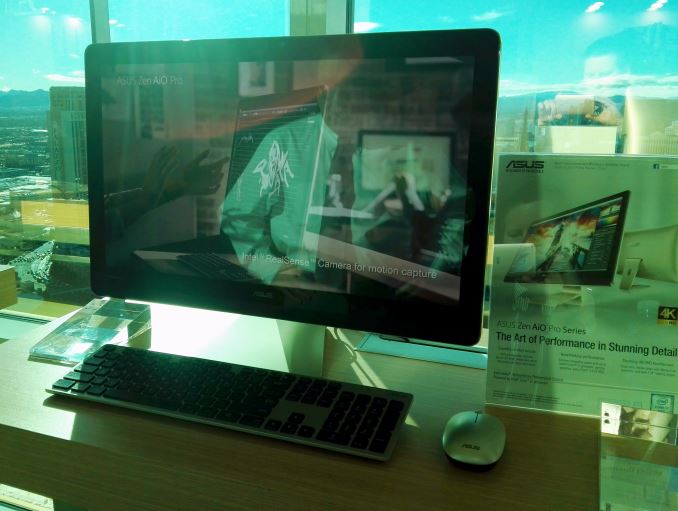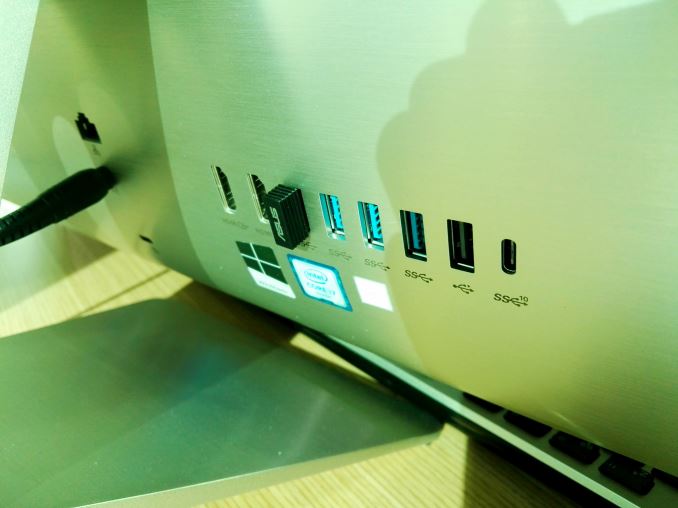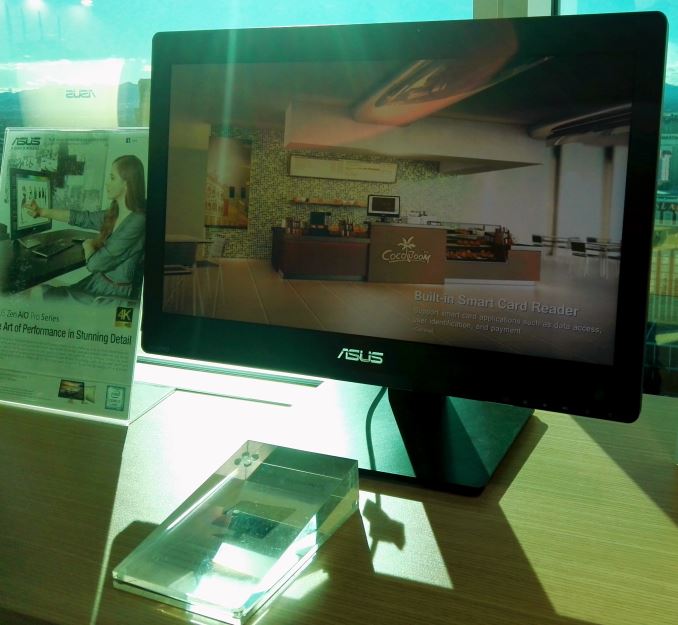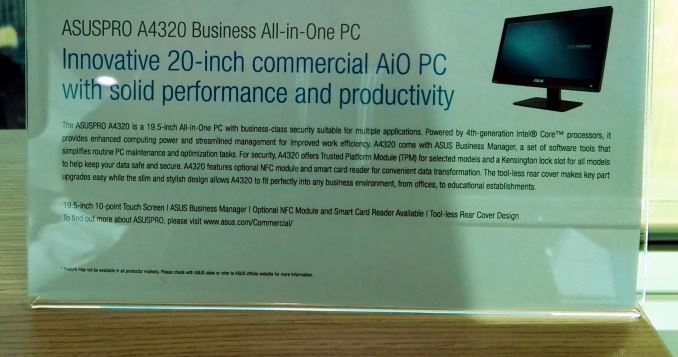ASUS Booth Tour at CES 2016: 10G Switches, External GPU Dock, USB-C Monitor and more
by Ian Cutress on January 19, 2016 9:00 AM ESTWith every passing show, we are seeing more and more all-in-one computers on display. I’m not knocking the form factor, but in my anecdotal evidence I do not see that many being used. Speaking to some of the AIO manufacturers, a lot of customers are actually business related, or related to certain vertical markets such as health, sales, education or manufacturing. As a result, we tend to see product categories like AIOs have very specialized design endpoints that meet certain requirements based on performance, style, particular features, or most importantly cost. Step in the Zen Pro AIO.
AIO goes Zen Pro
Zen is ASUS' premium style brand. We’ve seen Zen feature most prominently in products like the ZenFone, the Zen Watch and Zen Pad. If I recall correctly, back in Computex we saw the first generation of Zen monitors/all-in-ones ready to go. For CES, ASUS had the latest AIO model on hand.
It is quite clear what market ASUS is going for here – the iMac crowd. Everything about the Zen Pro is designed to be premium – the panel (up to 4K), the aluminium frame and finish, the RealSense Camera, support for USB 3.1, discrete graphics, raw CPU horse power, lots of memory and storage, and probably a kitchen sink as well.
The lack of clutter is an important point here, so we get similarly styled wireless mice and keyboards that work through nano-receivers on the rear panel and high quality WiFi internally. The model on display was the Z220IC, which is a 22-inch Full HD version, but there is also a Z240IC which has an optional UHD display. The Intel RealSense 3D camera is also available for Windows Hello facial login.
Next to the Zen AIO was a more conservative business focused model, with primary applications in the education and retail markets. The ASUSPRO model is a 20” AIO designed for commercial applications, and it can include a smartcard reader, VGA port, COM port, HDMI, and a tool-less back cover to access the internal components. There was nothing flashy about this model, but it certainly should fit the bill for specific instances where things like a COM port are necessary.















50 Comments
View All Comments
WhisperingEye - Wednesday, January 20, 2016 - link
Panzerknacker- I don't understand why you replied to a phone question with a router question.Xajel - Sunday, January 24, 2016 - link
The main reason behind this is that most consumer devices hardly sustain the 1Gb connection.. only some extreme consumers like heavy media servers at home that serves multi 4K stream...so for a consumer, 1Gb is enough, and there's no devices that can make use of 10Gb for the consumer...
Some advanced/enthusiast users uses a Link Aggregation connection as a backbone of their network ( NAS -> Switch <- HTPC/Main PC ) so these can serve multi streams in the same time without any drops... but that is rare as 1Gb is enough for most users already...
Maybe pro users, like pro video editing needs these 10Gb links, but it's already rare situation to see this in a home user, a person with the need for 10Gb ethernet is already using high-end workstations with professional systems.. so it's not a consumer oriented product any more...
Personally I thought about having 10Gb as a backbone for my home network just to be future proof.. but after looking again.. I found it too expensive, and I can make 2x 1Gb Link Aggregation which much less cost and still serve me well for few years a head ( NAS + HTPC + router + Switch all with LA connections )
Lieuchikaka - Thursday, June 2, 2016 - link
http://mavangvn.vn/ma-vang-dien-thoai/dien-thoai-s...Lieuchikaka - Thursday, June 2, 2016 - link
http://mavangvn.vn/ma-vang-dien-thoai/dien-thoai-s...rhx123 - Tuesday, January 19, 2016 - link
Using their own standard instead of TB3 just screams of Vendor Lock-In, especially when TB3 can do 36gbps over an active cable.SirKnobsworth - Tuesday, January 19, 2016 - link
According to Tom's, they actually require 2 type C cables too.Alexvrb - Tuesday, January 19, 2016 - link
Your statement is ironic to me because thunderbolt is itself... a proprietary standard. For external graphics we really need a standardized "Type G" port or something that can provide all the bandwidth by itself. But that will probably never happen. For that matter, even a much tamer enclosure hosting "only" up to 150W GPUs would still be a huge boost for a laptop.nathanddrews - Tuesday, January 19, 2016 - link
So... what are the implications of USB-C displacing HDMI and DisplayPort connectors? I know that it technically is DP over alternate mode, but it's clearly very popular. It seems like many new displays have it built in. Adaptive Sync? Latency? Would there be a penalty of some kind for sending video output through the USB bus instead of directly from the GPU?My only experience is with a first-generation USB display that sucked immense balls.
SirKnobsworth - Tuesday, January 19, 2016 - link
It's just a multiplexer that sends the signal over unused pins. You only get two lanes (as opposed to the usual 4), but that's fine as long as you don't need 4k60.Ryan Smith - Tuesday, January 19, 2016 - link
You can get 4 lanes of DP. It just uses up all the differential pairs, so you have to give up USB 3.x to get it (which is why DP 1.3 is going to be such a big deal).